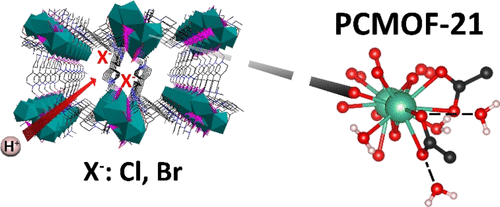当前位置:
X-MOL 学术
›
Chem. Mater.
›
论文详情
Our official English website, www.x-mol.net, welcomes your
feedback! (Note: you will need to create a separate account there.)
Effects of Secondary Anions on Proton Conduction in a Flexible Cationic Phosphonate Metal–Organic Framework
Chemistry of Materials ( IF 7.2 ) Pub Date : 2020-01-08 , DOI: 10.1021/acs.chemmater.9b03453 Daniel A. Levenson 1 , Jinfeng Zhang 1 , Patrick M. J. Szell 2 , David L. Bryce 2 , Benjamin S. Gelfand 2 , Racheal P. S. Huynh 2 , Nicholas D. Fylstra 2 , George K. H. Shimizu 2
Chemistry of Materials ( IF 7.2 ) Pub Date : 2020-01-08 , DOI: 10.1021/acs.chemmater.9b03453 Daniel A. Levenson 1 , Jinfeng Zhang 1 , Patrick M. J. Szell 2 , David L. Bryce 2 , Benjamin S. Gelfand 2 , Racheal P. S. Huynh 2 , Nicholas D. Fylstra 2 , George K. H. Shimizu 2
Affiliation

|
Four new phosphonate MOFs were prepared with cationic dimethylbipiperdinium units: [La2(H2L)1.5(AcO)2Br·3.25H2O], α-PCMOF-21-Br; [La2(H2L)1.5(AcO)Cl2·5.25H2O], α-PCMOF-21-Cl; [La(H2L) (AcO)Br0.5·4.93H2O(HBr)1.11], β-PCMOF-21-Br; and [La(H2L) (AcO)0.5Cl·5.42H2O(HCl)1.79], β-PCMOF-21-Cl. All frameworks have the same La phosphonate network structure but differ in the secondary anions (acetate, bromide, chloride), both coordinated and free. All frameworks showed the ability to dehydrate reversibly. Different phases result from very subtle differences in preparation; specifically, the degree of hydration of the ligand impacts the product phase even though syntheses are carried out in water. The alpha phases show a flexible structure by powder X-ray diffraction. The beta phases contain a reproducible stoichiometry of free ligands in the pores that both locks and partially fills the open structure. Alternating current impedance analysis was performed to study proton conductivity. All compounds, except for β-PCMOF-21-Cl, conduct better than 10–3 S cm–1 at 85 °C and 95% RH. The trends show that the alpha phases conduct better than the partially pore-blocked beta phases and also that the bromide structures conduct better than the chlorides. To further study the role of the anion, 35Cl and 81Br solid-state NMR was performed to elucidate dynamics. These studies also showed the ability of anions to be volatilized from the pores, and TGA–MS confirmed the loss of HX species. Impedance analysis showed a clear decrease in proton conductivity after the loss of the halides, more pronounced in the bromide-containing structures.
中文翻译:

次级阴离子对柔性阳离子膦酸酯金属-有机骨架中质子传导的影响
用阳离子二甲基双哌啶鎓单元制备了四个新的膦酸酯MOF:[ La 2(H 2 L)1.5(AcO)2 Br·3.25H 2 O ],α-PCMOF-21-Br;和[ La 2(H 2 L)1.5(AcO)2 Br·3.25H 2 O ]。[ La 2(H 2 L)1.5(AcO)Cl 2 ·5.25H 2 O],α-PCMOF-21-Cl;[La(H 2 L)(AcO)Br 0.5 ·4.93H 2 O(HBr)1.11 ],β-PCMOF-21-Br; 和[La(H 2 L)(AcO)0.5 Cl·5.42H 2 O(HCl)1.79 ],β-PCMOF-21-Cl。所有骨架均具有相同的La膦酸酯网络结构,但配位和游离的仲阴离子(乙酸根,溴离子,氯离子)不同。所有框架均显示出可逆脱水的能力。制备过程中的细微差别导致了不同的阶段。具体地说,即使合成是在水中进行的,配体的水合度也会影响产物相。α相通过粉末X射线衍射显示出柔性结构。β相在孔中包含可重现的自由配体化学计量,该化学配体既锁定又部分填充了开放结构。进行交流阻抗分析以研究质子传导率。除β-PCMOF-21-Cl外,所有化合物的导电性能均优于10 –3 S cm –1在85°C和95%RH下。趋势表明,α相的行为优于部分被孔堵塞的β相,并且溴化物结构的行为也优于氯化物。为了进一步研究阴离子的作用,进行了35 Cl和81 Br固态NMR阐明动力学。这些研究还显示了阴离子从孔中挥发出来的能力,TGA-MS证实了HX物种的损失。阻抗分析显示,卤化物消失后质子传导率明显下降,这在含溴化物的结构中更为明显。
更新日期:2020-01-08
中文翻译:

次级阴离子对柔性阳离子膦酸酯金属-有机骨架中质子传导的影响
用阳离子二甲基双哌啶鎓单元制备了四个新的膦酸酯MOF:[ La 2(H 2 L)1.5(AcO)2 Br·3.25H 2 O ],α-PCMOF-21-Br;和[ La 2(H 2 L)1.5(AcO)2 Br·3.25H 2 O ]。[ La 2(H 2 L)1.5(AcO)Cl 2 ·5.25H 2 O],α-PCMOF-21-Cl;[La(H 2 L)(AcO)Br 0.5 ·4.93H 2 O(HBr)1.11 ],β-PCMOF-21-Br; 和[La(H 2 L)(AcO)0.5 Cl·5.42H 2 O(HCl)1.79 ],β-PCMOF-21-Cl。所有骨架均具有相同的La膦酸酯网络结构,但配位和游离的仲阴离子(乙酸根,溴离子,氯离子)不同。所有框架均显示出可逆脱水的能力。制备过程中的细微差别导致了不同的阶段。具体地说,即使合成是在水中进行的,配体的水合度也会影响产物相。α相通过粉末X射线衍射显示出柔性结构。β相在孔中包含可重现的自由配体化学计量,该化学配体既锁定又部分填充了开放结构。进行交流阻抗分析以研究质子传导率。除β-PCMOF-21-Cl外,所有化合物的导电性能均优于10 –3 S cm –1在85°C和95%RH下。趋势表明,α相的行为优于部分被孔堵塞的β相,并且溴化物结构的行为也优于氯化物。为了进一步研究阴离子的作用,进行了35 Cl和81 Br固态NMR阐明动力学。这些研究还显示了阴离子从孔中挥发出来的能力,TGA-MS证实了HX物种的损失。阻抗分析显示,卤化物消失后质子传导率明显下降,这在含溴化物的结构中更为明显。









































 京公网安备 11010802027423号
京公网安备 11010802027423号